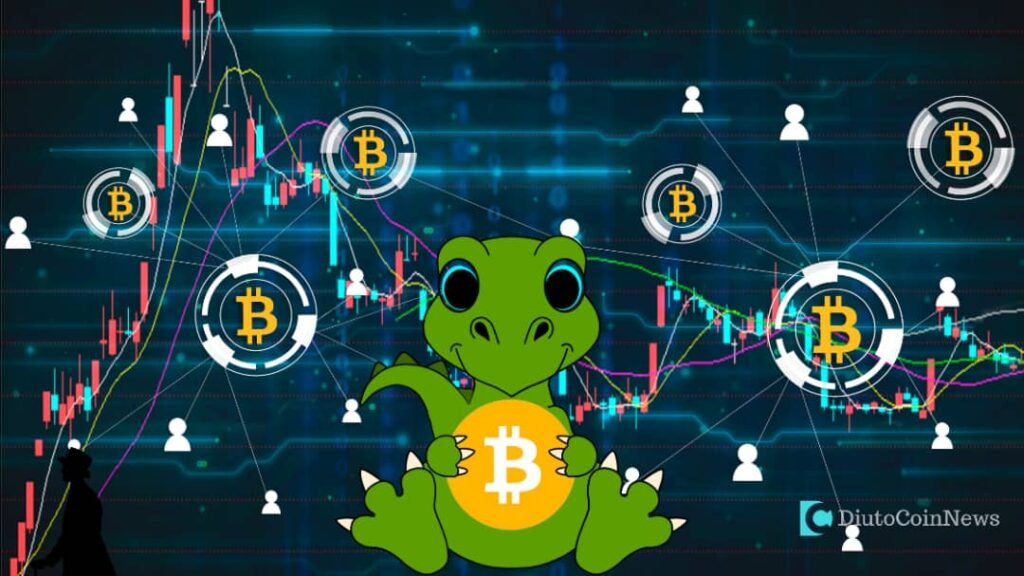Securities & Exchange Commission (SEC) Chair Gary Gensler suggested that spot ETH ETFs will likely receive approval over the course of the summer.
Some hours ago, the Chicago Board Options Exchange (CBOE) has confirmed that five spot Ethereum ETFs will go live on July 23. The stock exchange has updated its platform to include new listings from Fidelity, Invesco Galaxy, Franklin Templeton, VanEck, and 21Shares.
Moreover, there is a competition of fees where BlackRock introduced a starting fee of 0.12% for its iShares Ethereum Trust with a later fee of $0.25% making Franklin Templeton’s Franklin Ethereum Exchange-traded Fund (EZET) the cheapest pegged at 0.19% amongst others.
The entire crypto space is eagerly anticipating the listing and trading of the long-awaited spot Ethereum ETF. In a brief with DiutoCoinNews, CEO of CoinEx Haipo Yang, a renowned figure in the crypto industry, explained how the spot Ethereum ETF might impact the Ethereum market.
Crypto Exchange Traded Funds (ETF)
Haipo explained an ETF (Exchange-Traded Fund) as a financial product that tracks the performance of an underlying asset, such as Ethereum, and is traded on stock exchanges.
If an Ethereum ETF is approved, it could make investing in Ethereum more accessible to both institutional and retail investors. This increased accessibility might drive up demand and potentially raise Ethereum’s price, he said.
Going further, Haipo added that, an ETF would further legitimise Ethereum as an asset class, boosting investor confidence. The increased trading volume from an ETF could also enhance market liquidity, leading to a more stable Ethereum market. Overall, the introduction of an Ethereum ETF could significantly impact the cryptocurrency market by promoting wider adoption and stability.
Price impact of Ethereum ETF on the native Ethereum market
Why many analysts anticipate a surge in price, Haipo believes in staying committed to providing users with high-quality and timely information to help them make informed investment decisions themselves. He also highlighted that
“In the short term, price movements are difficult to predict. Some short-term investors may have already bought in anticipation of the ETF approval and might sell off to take profits once it is officially approved, potentially leading to increased price volatility. However, in the long term, the approval of the ETF will be a positive development, attracting more investors to the market and increasing Ethereum’s adoption and market participation.
This will enhance market liquidity and stability, helping Ethereum’s price to rise steadily over time. Overall, while significant volatility might occur in the short term, the ETF approval will have a positive impact on the Ethereum market in the long run.”
In the long-term, Haipo sees the impact of Ethereum ETF influencing the ethereum market and the crypto market at large. In the long-term growth and adoption of Ethereum, Haipo believes that the Spot Ethereum ETF will bring in new liquidity from the traditional financial markets.
“In fact, Ethereum’s price has underperformed compared to Bitcoin and other major cryptocurrencies in the current bull cycle. The launch of an Ethereum ETF is expected to bring new liquidity from traditional financial markets, serving as a positive catalyst, much like the Bitcoin ETF did this year.” says Haipo
Decline in ethereum onchain activity
CoinEx CEO also explains that the capital influx is expected to drive the development and adoption of Ethereum. Despite that, there has been no lack of capital and developers in the Ethereum ecosystem over the years.
“In my view, instead of viewing the Ethereum ETF as merely another market narrative, it should be seen as an opportunity for ecosystem builders to reflect and strategize on how to achieve mass adoption, whether through scaling solutions, non-defi applications or proof of identity, the three cores of Ethereum’s development highlighted by Vitalik Buterin in the past.”
“Looking at the builders building on ethereum network mainnet compared to other layer 2 networks on the ethereum network, there seems to be a diverse increase in the builders building on the layer 2 chains. The launch of several layer 2 tokens this year highlights the ecosystem’s focus on scalability,” he said.
There is also a decline in ethereum onchain activities according to Coinstats. Further comments highlights the observed decline in on-chain activities and the low gas fees in the single-digit gwei range raise questions about current user engagement and network utilisation. “This could indicate a need for more compelling use cases and applications to drive sustained activity on the network.”
Possible increase in Net Inflows on spot Ethereum ETF following listings
Currently, asset tokenization is a top driving onchain activity bringing increased funds inflow to ethereum. Haipo believes that it’s just a matter of size.
“Drawing from the Bitcoin ETF lesson, which saw over $15 billion in net inflows in six months, the ETH ETFs are expected to attract substantial but smaller inflows due to their different value propositions, from my point of view. Based on my rough estimation, the net inflows to the Ethereum ETFs could be one-third to one-half of Bitcoin’s, translating to approximately $5 billion to $7.5 billion over six months post-approval.
As far as I understand, some traditional investors currently allocate only a small portion of their portfolios to cryptocurrencies, say low single-digit, with many still evaluating the sector. The availability of an Ethereum ETF will likely attract hesitant investors, gradually increasing inflows.”
Key advantages and potential risks of investing in ETH ETF compared to directly investing in Ethereum?
Advantages:
- Ease of Purchase: ETH ETFs can be bought through regular brokerage accounts, making them accessible to traditional and retail investors with limited crypto knowledge.
- Security: ETFs eliminate concerns about hacking or losing private keys. Investors also enjoy certain investor protection under regulatory oversight.
- Simplified Tax Reporting: ETFs typically provide easier tax reporting compared to direct cryptocurrency holdings.
Risks:
- Loss of Control: Investors in ETH ETFs cannot manage or utilize their Ether directly, such as participating in staking. ETH ETFs do not offer staking, resulting in missed opportunities for earning approximately 3.2% returns available to direct holders who stake their Ethers.
- Limited Trading Hours: ETFs are traded during market hours only, unlike the 24/7 trading availability of cryptocurrencies.
- Potential Underperformance: ETFs imply management fees and tracking errors, which can lead to slight underperformance compared to direct Ethereum holdings.
Ethereum Liquidity Exposure for Cryptocurrency Exchanges
Following the launch of spot Bitcoin ETF, we saw liquidity moving towards custodian cryptocurrency exchanges that hold these onchain Bitcoins. We saw exchanges like Coinbase gulping far more possessions of bitcoin on its exchange than others.
Haipo believes that with the entry of institutional investors, pricing power might gradually shift to Wall Street. Large institutions have stronger capital and market influence, meaning their trading activities will have a greater impact on market prices.
Furthermore, highlighting the arbitrage benefits, Hapio said that it could lead to a more concentrated market, reduced price volatility, and more rational and stable pricing. “For regular investors and retail traders, market opportunities might decrease, and arbitrage opportunities could diminish.”
Additionally, he believes that the involvement of Wall Street might bring more regulatory and compliance requirements, increasing market transparency and security. Overall, the entry of institutional investors will significantly change the market structure and pricing mechanisms.
Ethereum ETF Staking and Returns
Just as seen with the proposal submitted by 3iQ for Solana ETP listing in Canada, there is a proposed return of around 6-8% from accrued interest generated on the native SOL staking yields for the holders.
Though Ethereum ETF issuers have removed staking from their applications to secure regulatory approval. Haipo thinks it likely that should regulatory bodies allow staking in the future, it would be reasonable for investors to be entitled to Ethereum native staking yields.
Already, CoinEx supports one-click Ethereum native staking as long as you are a registered CoinEx user and have completed 2FA authentication. You can use CoinEx Staking.
“In such a scenario, the returns generated from staking should logically be considered part of the fund’s overall earnings. However, the specific entitlement to these returns would ultimately depend on the fund’s terms and the structure of the ETF.”
Comparing Ethereum ETF Investors and Bitcoin ETF Investors
While these two digital assets serve different investment ideas for investors, Yang calls them complementary investment tools.
He explains that Ethereum ETFs and Bitcoin ETFs will coexist, fulfilling different aspects of investor demand rather than directly competing for market share.
“From the perspective of the cryptocurrency market, Bitcoin is often seen as a store of value and “digital gold,” while Ethereum is viewed as a platform for decentralized applications and smart contracts. This distinction attracts crypto investors with different investment philosophies.”
Futhermore, Bitcoin ETFs might attract investors looking to hedge against inflation and economic uncertainty, while Ethereum ETFs could appeal to those interested in blockchain technology and utility.
Diversification, according to Yang, is another strategy that can subsequently attract different groups of investors. He is of the opinion that in the future, investors who already hold Bitcoin ETFs might diversify their crypto-themed investments by adding Ethereum ETFs. Also, it can attract more crypto ETFs listings.
“This diversification could increase capital inflow into Ethereum ETFs without necessarily reducing Bitcoin ETF holdings.”, he said.
New Potential Future ETFs to Launch
We have seen 3iQ, a crypto asset management file for Solana ETP (Exchange Traded Product) similar to ETF in Canada to be listed on the Toronto Stock Exchange under QSOL ticker upon approval. Haipo believes it’s only a matter of time before more cryptocurrency ETFs are approved, continuing the momentum seen with Bitcoin and Ethereum.
“VanEck and 21Shares have already filed for the first Solana ETF. Based on Solana’s level of decentralization, network security, market size, and liquidity, I expect it to be the next approved ETF. However, I anticipate that the launch of the Solana ETF might happen next year rather than this year, so investors should remain cautious about any surge in market sentiment,” he said.
Amongst other cryptocurrency trends, he explored the meme tokens space, TON network, which has integrated web 2 and web 3 features together and also the recent trends of the AI agents.
“Meme tokens have become a significant trend in the cryptocurrency market. Various ecosystems, including Solana, Base, and Avalanche, explicitly support the development of meme tokens. These tokens gain popularity due to strong community participation and viral marketing, driving significant market interest and liquidity.”
“The TON ecosystem is another area worth noting. With its large Web2 user base, TON has the potential to integrate seamlessly Web2 and Web3 technologies. This ecosystem is still in its early stages with many promising projects in development. This early stage presents significant growth and innovation opportunities, making it a notable ecosystem.”
“The field of Artificial Intelligence (AI) is particularly fascinating, especially its intersection with blockchain technology. In AI, there are three main subfields: computing resources, AI agents, and data. I am particularly interested in AI agents as they are most likely to achieve widespread adoption and effectively connect Web2 and Web3 users.”
Hong Kong and United States Spot Ethereum ETF Markets
Comparing the impact of the first listing of spot Ethereum ETF in Hong Kong (a special administrative region of China) and its impact on the United States spot Ethereum ETF listing processes.
Yang believed the approval of Ethereum ETFs in Hong Kong exerts minimal or no pressure on the United States to follow suit. One primary reason is the significantly low daily trading volume of these three Ethereum ETFs, which consistently remains below $2 million on most trading days, he said.
“This low trading activity indicates a limited market representation and suggests that these ETFs do not yet play a substantial role in the broader financial market.”
Additionally, it is important to consider the current political landscape in the United States. Yang thinks it likely that the approval of an Ethereum ETF appears to be increasingly intertwined with political agendas, particularly as presidential election candidates outline their positions on financial innovation and regulatory reform.
“Recent legislative actions, such as the passage of the FIT21 bill by the U.S. House in May underscores a growing acknowledgement of the need for clear and supportive regulatory frameworks for the cryptocurrency and blockchain sectors.
These legislative developments indicate a trend towards establishing a more defined and encouraging regulatory environment, which could be a crucial factor in future ETF approvals.”
Impact of the Ethereum ETF on the regulatory landscape for other cryptocurrencies and blockchain technologies.
On June 30, 2024, we saw the new European Union MiCA (Market in-Crypto Assets Regulation) laws, which affects stablecoins in these regions taking effect.
Regulatory agencies are becoming increasingly familiar with the cryptocurrency sector. Yang counts on the approval of an Ethereum ETF also highlighting the growing political interest in cryptocurrency regulation.
“Notably, former President Trump has publicly expressed support for cryptocurrency, which has garnered widespread attention and support from various stakeholders.”
“Additionally, there has been a significant increase in the number of cryptocurrency-related bills and proposals being processed and approved. Recent legislative actions, such as the FIT21 bill passed by the U.S. House in May indicates a growing acknowledgement of the importance of establishing clear and supportive regulatory frameworks for cryptocurrency and blockchain. These developments suggest that the regulatory environment is moving toward a more defined and supportive direction.”
Recent New Developments on Ethereum Ecosystem
There are already many layer 2 chains on the ethereum network and investors utilize ethereum virtual machine compatible wallets like the CoinEx Wallet, a crypto and defi wallet to manage their assets. The Ethereum ecosystem according to Yang has accumulated a large developer community and sticky user base.
Its infrastructure according to him, is robust and mature. “The last bull market gave rise to DeFi Summer, NFT Summer, and GameFi Summer. This cycle also sees new products like Friend Tech and Farcaster emerging in the Social track. Social products are highly defensible once established, and this cycle may witness the emergence of such giants.”
Going further, Restaking, an innovative business model in blockchain space, is another track worth watching, including projects like AVS, he said.
“This cycle’s chain launches are highly efficient, mature, and low-cost. Layer 2 and Layer 3 solutions are sprouting up rapidly, with various games, social, and even Meme App Chains complementing each other, potentially giving rise to some blockbuster projects.”
Cryptocurrency Adoption
Yang strongly agrees that the widespread adoption of cryptocurrencies is imminent. The concept of ‘going mainstream’ is crucial for crypto projects, especially in the current cycle.
“This year, we’ve witnessed various projects, from meme tokens on Solana to small games in the TON ecosystem, gaining mainstream attention and success. The common thread among these successes is their ability to break through the traditional crypto audience constraints.”
In his opinion, the crypto world still lacks broad real-world applications for mass adoption. “I believe the industry urgently needs a ‘killer app’ for Web3 that surpasses the practicality and user experience of popular Web2 applications. I expect this breakthrough to occur in the coming years, driving significant growth and adoption.”
Speaking on the future world of blockchain technology, Yang highlights the importance of Blockchain stating that it has not only created assets and payment tools free from sovereign control but also granted individuals the freedom to issue assets.
“I decided to establish a centralized exchange (CEX) like CoinEx because it is a powerful business model that aggregates numerous assets, allowing people to trade freely, exchange conveniently, and realize the free flow of capital, playing a vital role in the industry.
Our goal is very clear—to build a reliable and professional cryptocurrency trading platform. The concept of “user first” guides every decision, innovation, and action we take. In product development, we focus primarily on the fundamental needs of users—asset storage and trading.
My team and I constantly monitor industry trends, and we have a well-structured team.”
About Haipo Yang:
Haipo Yang graduated from Northwestern Polytechnical University in 2012 with a degree in Mathematics and Applied Mathematics. His illustrious career includes positions at Tencent and Futu Securities. Between 2014 and 2015, he served as the technical director at Zeus Technology, a top-three SCRYPT mining machine brand globally, before venturing into entrepreneurship in the Bitcoin industry.
A pioneer in the Bitcoin space since 2011, Haipo Yang actively engaged with the Bitcoin community from 2013 onwards. In March 2016, he invested in and independently developed the codes for the ViaBTC mining pool, successfully launching it just two months later
The CoinEx Journey:
In 2017, Yang Haipo founded CoinEx, a global cryptocurrency exchange dedicated to simplifying trading. Since its inception, CoinEx has unwaveringly followed a “user-first” service principle. With a genuine commitment to fostering an equitable, respectful, and secure crypto trading environment, CoinEx empowers individuals of varying experience levels to effortlessly access the world of cryptocurrency through user-friendly products.
Discover more from DiutoCoinNews
Subscribe to get the latest posts sent to your email.















